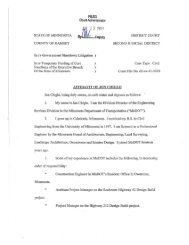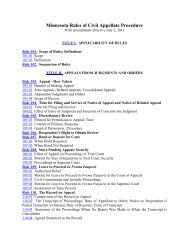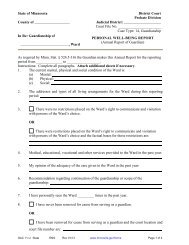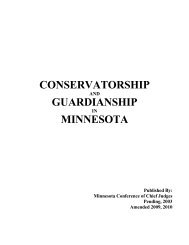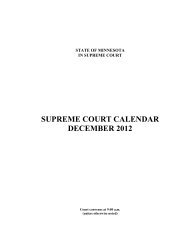2001-01-26 Harley-Davidson Response - Minnesota Judicial Branch
2001-01-26 Harley-Davidson Response - Minnesota Judicial Branch
2001-01-26 Harley-Davidson Response - Minnesota Judicial Branch
You also want an ePaper? Increase the reach of your titles
YUMPU automatically turns print PDFs into web optimized ePapers that Google loves.
In a case directly on point, the <strong>Minnesota</strong> Court of Appeals recognized that consolidation is<br />
improper and prejudicial where the actions giving rise to the various claims occurred on separate<br />
dates and therefore necessarily involved separate and distinct factual determinations. Green v. City<br />
of Coon Ranids, 485 N.W.2d 712 (Minn. App. 1992). Green involved numerous claims by<br />
individuals who alleged they were exposed to elevated levels of nitrogen dioxide at an ice arena<br />
operated by the City of Coon Rapids. The alleged exposure occurred on several different dates.<br />
Resolution of the claims therefore required separate factual determination of the conditions in the<br />
arena on the days visited by each claimant. The Court properly recognized it would be too<br />
*-<br />
confusing and prejudicial to consolidate the claims due to the separate factual determinations<br />
required:<br />
Id. at 718.<br />
In denying the plaintiffs’ motion to consolidate, the trial court stated the<br />
decision rested upon the same grounds as those cited by the trial court in denying<br />
the motion to proceed as a class. The court found it crucial that evidence showed<br />
conditions at the arena varied fi-om day to day and from event to event. The trial<br />
court thus concluded that whether the city’s negligence caused harm on any given<br />
day could be resolved only by considering the circumstances surrounding the day<br />
on which a claimant visited the arena. . .<br />
. . .The case is unique because a group of claimants allege similar kinds of<br />
exposures, but on a number of individual occasions. The numerous claims, the<br />
differing conditions associated with each exposure, and the great quantity of<br />
evidence specific to each individual plaintiff could be unduly confusing in a single<br />
trial. The trial court did not err.<br />
In another case directly on point, the Supreme Court for New York County, New York ’<br />
”<br />
rejected an attempt by the claimants to improperly consolidate multiple claims * lving unique<br />
T<br />
and independent issues of fact. Korren v. Eli Lillv & Comnanv, 568 N.Y.S.2d 670 (1990). Korren<br />
involved multiple claims against manufacturers of the drug diethylstilbestrol (DES) to recover for<br />
injuries allegedly caused by ingestion of DES during pregnancy. Claimants sought to consolidate<br />
6<br />
b





